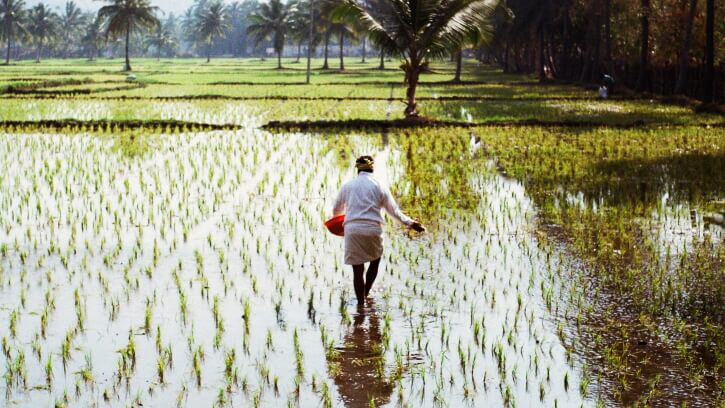Rice, a staple for nearly half the world's population, faces challenges in nitrogen use efficiency (NUE) in irrigated systems. A major cause of this issue is the long-term application of mineral fertilisers, which contributes to higher production costs and environmental pollution.
In irrigated systems, nitrogen risks being lost through leaching when water percolates through the soil, carrying away soluble nitrogen with it and leading to a significant reduction in nitrogen availability for the rice plants. Nitrogen fertilisers can also undergo volatilisation, where the nitrogen is converted into gaseous forms and lost to the atmosphere. This is more likely in flooded rice fields where anaerobic conditions promote the ammonium conversion to gaseous forms.
Denitrification is another risk in flooded conditions (especially in rice paddies), whereby soil microbes convert nitrate nitrogen into nitrogen gases that are then released into the atmosphere, reducing the nitrogen available to the rice plants.
Furthermore, improper application or uneven distribution of fertilisers can result in localised excesses or deficiencies of nitrogen in the soil, affecting the overall efficiency of rice plants’ nutrient uptake. And with international fertiliser supplies facing constraints, there is a growing need for sustainable alternatives to mineral fertilisers.
The rice of alternative fertlisation
In Spain, where pig slurry production is substantial, researchers conducted a study — led by the Institute of Agrifood Research and Technology — to explore its potential as an organic fertiliser for rice cultivation and address environmental, resource and geopolitical concerns associated with nitrogen fertilisers.
The study, conducted over six years in rice fields, also considered the use of poultry by-products like chicken manure as efficient manures by exploring fertilisation strategies. These included the use of pig slurry and chicken manure in combination with mineral fertilisers, mineral-only fertilisation, and zero-fertilisation.
The researchers meticulously measured key parameters such as agronomic traits, yield, spectral responses and nutrient content and employed the Sentinel-2 remote sensing system to monitor crop development.
The results indicated that thanks to nitrogen deficiency in the late vegetative stages, the cost-effective organic fertilisers, pig slurry and chicken manure, led to a respective 13% and 15% reduction in yield compared to mineral-only fertilisation. The organic fertilisers were also found to be lower in nutrients, leading to slower nutrient release compared to that of mineral fertilisers.
Still, even with the reduction, organic fertilisers saw double the yield of zero-fertilisation crops. At the same time, pig slurry proved effective in reducing nitrogen leaching, and the heavy metal levels in the organically fertilised rice grains were found to be within safe limits.
A closer look at nutrient content in the grains revealed that prolonged use of mineral fertilisation alone resulted in higher concentrations of certain heavy metals, compared to non-fertilised crops. Pig slurry and chicken manure treatments fell in between, with concentrations not significantly different from either the mineral fertilisation or control group.
The study further reported that compared to other strategies, six-year chicken manure fertilisation significantly enriched the soil in phosphorus and potassium, while mineral-only fertilisation led to a decrease in available phosphorus. Soil moisture, nitrogen concentrations and ammonium content also varied across fertilisation methods.
The researchers looked at fungal disease incidence among the different fertilisation methods and found that mineral-only fertilisation led to increased Pyricularia oryzae infection, while Bipolaris oryzae affected chicken manure and control treatments more.
They observed differences in growth patterns between fertilisation methods, with mineral-only fertilisation consistently outperforming organic fertilisation in the early stages. However, organic fertilisation treatments were able to recover and maintain Normalized Difference Vegetation Index (NDVI) values equivalent to mineral-only treatment after the second top-dressing.
Remote senses
The study employed Sentinel-2 remote sensing to manage nutrient deficiencies and optimise fertilisation programmes, highlighting the importance of monitoring heavy metal content in rice grains and conducting exhaustive analysis before manure application.
Sentinel-2 remote sensing could be a game-changer in optimising fertilisation strategies for rice cultivation in Spain, thanks largely the benefits its satellite imagery offers. These include vegetation monitoring, whereby the system can assess of rice crop health by monitoring vegetation indices like NDVI to identify areas with nutrient deficiencies or stress.
Sentinel-2’s satellite data can be used to analyse the soil’s nutrient content, allowing farmers to tailor their fertilisation plans to address specific deficiencies. The system’s satellite imagery can also help in the early detection of diseases or pest infestations, allowing farmers to take corrective measures and adjust fertilisation strategies accordingly.
Moreover, Sentinel-2’s high spatial resolution enables precision farming by allowing farmers to target specific zones within a field that require additional organic or mineral fertilisation, reducing wastage and environmental impact.
Additionally, Sentinel-2 can aid in monitoring water levels, ensuring an efficient irrigation process and, through the analysis of its historical data, enabling farmers to make informed predictions about potential yields.
Not only can utilising Sentinel-2 data for monitoring and decision-making can be cost-effective compared to traditional ground-based methods, it can provide a broader perspective and allow farmers to make timely, well-informed decisions.
Strategy for sustainability
The researchers concluded the study with an emphasis on the need for a balanced approach that combined organic and mineral fertilisers for optimal soil fertility and crop production, while also underscoring the significance of real-time monitoring using Sentinel-2 NDVI measurements to detect nutritional stress and optimise fertilisation schedules.
The combined use of organic and mineral fertilisers, guided by remote sensing technology, they wrote, would facilitate sustainable rice cultivation and enhance crop productivity while minimizing environmental impact.
Source: National Center for Biotechnology Information
“Agronomic performance and remote sensing assessment of organic and mineral fertilization in rice fields”
https://doi.org/10.3389/fpls.2023.1230012
Authors: Karen Marti-Jerez, et al.




